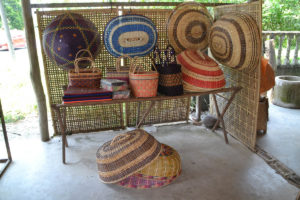
The Malays of the Peninsula have long plaited, twisted and coiled a variety of plant fibres obtained from forests, swamps and coastlines to make functional as well as decorative objects. Two varieties of screw pine from the Pandanus genus—the shorter, finer and softer leaves of pandan and the broader, longer, less pliable but more durable leaves of mengkuang—as well as the young leaves of the coconut palm (pucuk kelapa) and the strong, light, smooth and straight canes of rattan (rotan) and bamboo (buluh) are the main raw materials.
Pandan and mengkuang leaves—trimmed of thorns and spines, cut into thin strips, soaked, sun-dried and dyed with commercial dyes (formerly natural dyes)—are plaited by Malay women in the coastal states of Kelantan, Terengganu and Melaka into flat mats and fans and three-dimensional baskets, bags, pouches and food covers. The plaited patterns, called kelarai, are worked diagonally in a basic twill beginning either at a corner or the centre to form a variety of patterns with age-old names derived from nature in bold complementary or contrasting colours. Terengganu Malay women are particularly noted for the fineness of their mat weaving and the variety of their patterns. A master craftsman from Melaka, Ishak bin Kassim, is also known for his plaiting techniques using mengkuang leaves.
Bamboo was traditionally used in the Malay Peninsula for the construction of walls (woven of bamboo strips), floors and ladders of rural Malay houses and for holding the leaf roofing (atap) in place, as well as for making weapons, traps and containers. After the bamboo was selected, cut and measured, it was soaked in muddy water for a week to remove the sugar for protection against insects, cured over a fire, dried, then pared into thin strips and, if desired, dyed. Today, bamboo products, their parts often bound using pliable rattan strips, include furniture, household items like lampshades and baskets, and birdcages. Climbing rattans are very difficult to harvest and strip of their thorny outer skin, but being solid they are more durable and versatile than bamboo and also more pliant. Rattan is a choice material for furniture and for sturdy baskets and mats.
Written in collaboration with Fiona Wong






